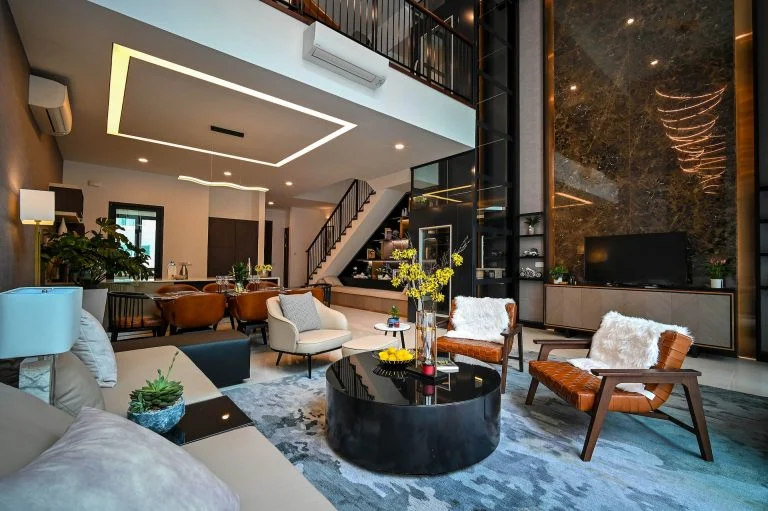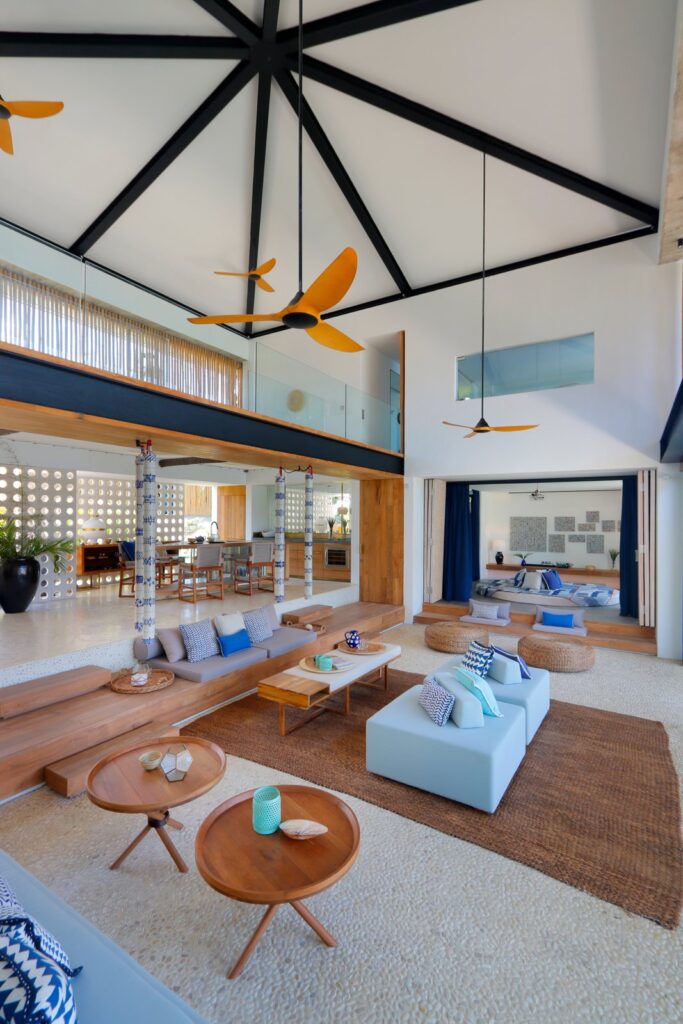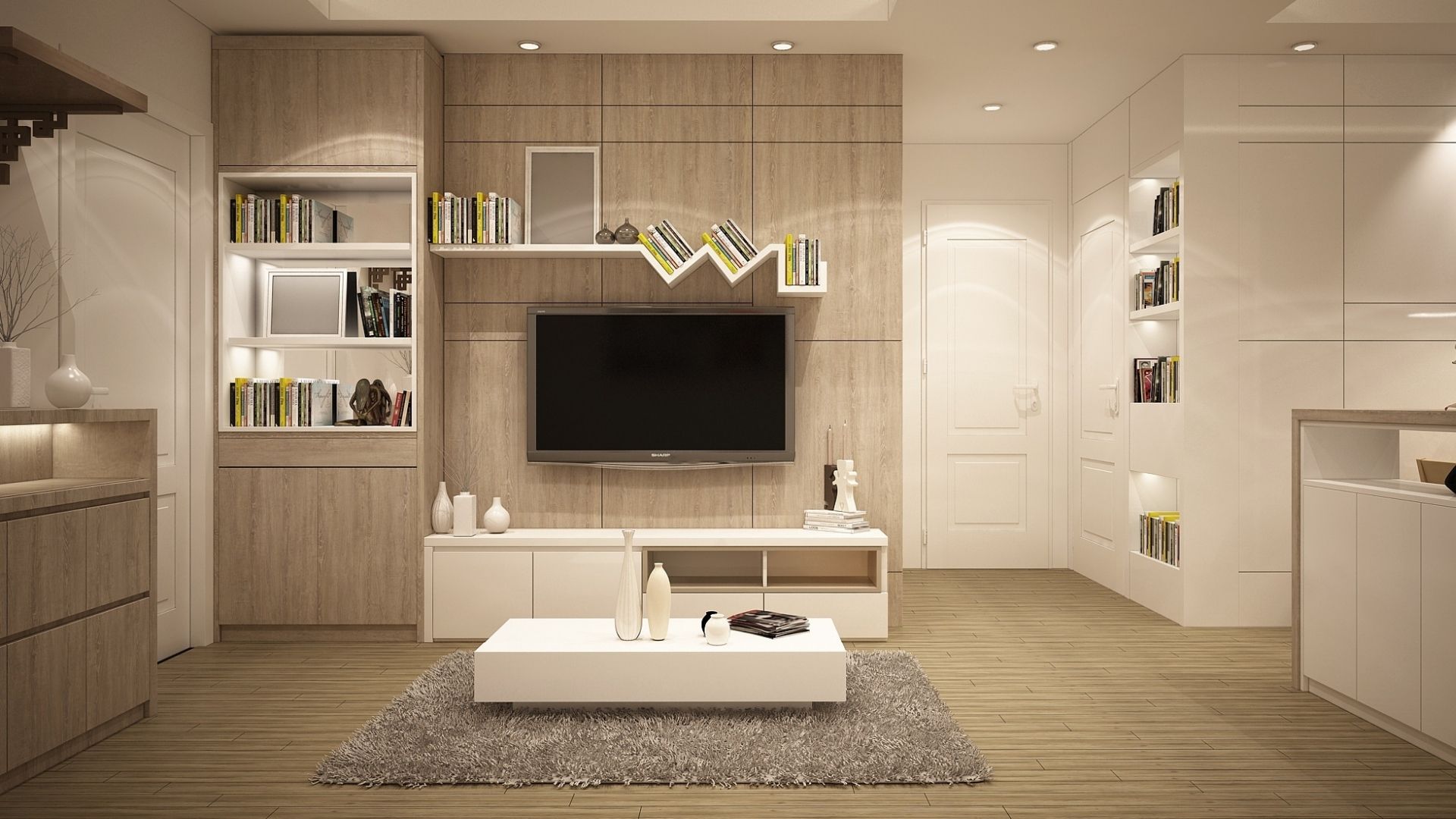Discover how a soaring ceiling can crown your home with an air of majesty and elegance. Explore the art of transforming rooms into palatial havens through the magic of high ceilings.

What We'll Cover
ToggleHigh Ceilings for your Home
Experience the grandeur and spaciousness of high ceilings in key areas of your home. From the airy elegance of the living room to the regal comfort of the bedroom, and the impressive entryway and staircase designs, discover how tall ceilings can transform your living spaces into majestic retreats.

High Ceiling in Living Room
A High ceiling in a living room offers a sense of grandeur and spaciousness, allowing for striking decor elements and abundant natural light. While it adds aesthetic appeal and the potential for dramatic design, it may require thoughtful consideration of temperature control, acoustics, and appropriate decor to strike a harmonious balance between grandeur and comfort. Careful furniture placement, proper lighting choices, and strategic design can transform a living room with a High ceiling into an inviting and visually captivating space.
High Ceiling in Entryway
A High ceiling in an entryway imparts a sense of grandeur and sophistication, setting the tone for a memorable first impression. It offers an opportunity to create a dramatic entrance with statement lighting fixtures, elegant architectural features, and luxurious materials. While it elevates the space’s aesthetics, it may require careful consideration of decor and lighting to maintain a welcoming ambiance. Thoughtfully selected furniture, rich color palettes, and vertical decor elements can harmonize the vertical space and transform the entryway into a captivating and inviting gateway to your home
High Ceiling in Stairway
A High ceiling in a stairway can transform it into a stunning architectural centerpiece. It provides an opportunity for dramatic vertical design elements and abundant natural light, enhancing the overall aesthetics. However, it can present challenges related to lighting, acoustics, and decor. Thoughtful lighting fixtures, such as impressive chandeliers or pendant lights, along with carefully selected materials and design elements, can accentuate the height while maintaining a harmonious and inviting atmosphere. Balancing grandeur with functionality is key to creating a captivating stairway that leaves a lasting impression.
High Ceiling in Bedroom
Bedrooms are essential living spaces within a home, and their architectural design can vary widely depending on the overall style and layout of the house. Architects consider factors such as room size, layout, and the placement of windows and doors when designing bedrooms. In some cases, architects may incorporate architectural elements like tray ceilings, bay windows, or built-in storage to enhance the functionality and aesthetic appeal of the bedroom. The architectural design of a bedroom should prioritize comfort, privacy, and access to natural light.
Are High Ceilings Worth the Heightened Challenges?

Aesthetic Appeal:
High ceilings can make a room feel more spacious, open, and grand. They create a sense of airiness and can enhance the overall aesthetic of a space, making it appear more elegant and luxurious.
Natural Light:
High ceilings often allow for larger windows or the possibility of adding High windows, which can bring in more natural light. This can help reduce the need for artificial lighting during the day and create a more welcoming atmosphere.
Room for High Decor:
With High ceilings, you have the opportunity to incorporate Higher or more dramatic decor elements, such as large chandeliers, High bookshelves, or artwork that extends upward. These can be eye-catching focal points in the room.
Temperature and Energy Considerations:
High ceilings can be challenging to heat or cool efficiently. Heat rises, so in the winter, a room with a High ceiling may feel colder, while in the summer, it may be harder to keep cool. This can lead to increased energy costs for heating and cooling.
Acoustic Challenges:
High ceilings can contribute to poor acoustics, as sound tends to bounce around more in Higher spaces. To address this, you might need additional acoustic treatments or rugs and furniture that absorb sound.
Decorating Challenges:
Decorating High spaces can be a bit tricky. You may need Higher ladders or equipment to reach high areas for maintenance or decoration. Additionally, selecting appropriately sized furniture and decor to fill the vertical space can be a design challenge.
Lighting Choices:
You’ll need to carefully consider lighting options for High ceilings. Pendant lights, chandeliers, or track lighting can be effective in illuminating the space, but they should be chosen with the height of the ceiling in mind.
Architectural Variations:
Not all High ceilings are the same. Some homes have vaulted ceilings, while others may have cathedral ceilings, tray ceilings, or simply higher-than-average standard ceilings. Each type has its own architectural nuances and design considerations.
Advantages and Disadvantages of High Ceiling

Advantages of High Ceiling
High ceilings offer several advantages in both residential and commercial spaces. Here are some of the key benefits:
Sense of Spaciousness:
High ceilings create a feeling of openness and spaciousness in a room. They make a space appear larger than it actually is, which can be particularly beneficial in smaller rooms.
Aesthetic Appeal:
High ceilings add architectural interest and visual appeal to a space. They often convey a sense of grandeur and luxury, making a room more attractive and impressive.
Natural Light:
High ceilings allow for larger windows and more natural light to enter a room. This can make the space brighter and more inviting, reducing the need for artificial lighting during the day.
Room for Decor:
High walls provide more vertical space for artwork, decorative features, and High furniture pieces like bookshelves or cabinets. This allows for more creative interior design and the display of larger or more prominent decor items.
Better Ventilation:
Higher ceilings can improve air circulation and ventilation in a room. Hot air tends to rise, so high ceilings can help disperse it, creating a more comfortable environment, especially in warmer climates.
Sound Acoustics:
High ceilings can enhance the acoustics of a room. They reduce sound reflections and reverberations, making the space ideal for home theaters, music rooms, or other areas where sound quality is important.
Flexibility in Lighting:
High ceilings provide opportunities for unique and dramatic lighting fixtures, such as chandeliers or pendant lights. These fixtures can become focal points of the room’s design.
Improved Temperature Regulation:
In regions with extreme temperatures, high ceilings can help regulate indoor temperatures. They allow hot air to rise in the summer, reducing heat buildup, and can trap warmth closer to the floor in the winter, improving energy efficiency.
Versatile Design:
High ceilings offer versatility in terms of room layout and design. They can accommodate mezzanines, lofts, or multi-level living spaces within the same room, adding architectural interest and functionality.
Increase Property Value:
Homes or commercial properties with high ceilings often have a higher resale value due to their perceived luxury and spaciousness.
Disadvantages of High Ceiling
It’s important to note that while high ceilings have many advantages, they also come with some challenges, such as increased heating and cooling costs, potential for difficult maintenance in very High spaces, and the need for appropriate decor and furnishings to make the most of the vertical space. Proper planning and design are essential to fully harness the benefits of high ceilings in any given space. While high ceilings can offer many advantages, they also come with certain disadvantages and challenges. Here are some of the potential drawbacks of high ceilings:
Increased Heating and Cooling Costs:
High ceilings can lead to higher energy bills because it takes more energy to heat or cool a space with greater volume. This can be especially problematic in homes with inefficient insulation and HVAC systems.
Difficulty in Temperature Regulation:
High ceilings can make it challenging to maintain consistent temperatures throughout the room. Warm air rises, so in the winter, it can be cooler near the floor, while in the summer, hot air can accumulate near the ceiling, leading to discomfort.
Higher Construction and Maintenance Costs:
Building or renovating a space with high ceilings can be more expensive due to the need for extra materials and labor. Cleaning and maintaining High ceilings, especially in commercial buildings, can also be more costly and time-consuming.
Acoustic Challenges:
High ceilings can create acoustic issues, including echoes and sound reverberation. This can be a problem in spaces where clear communication or sound quality is essential, such as conference rooms or open-plan offices.
Difficult to Reach:
Maintenance tasks, such as changing light bulbs, painting, or cleaning, can be more challenging and may require specialized equipment or professional assistance.
Less Cozy Atmosphere:
In residential spaces, high ceilings can sometimes make a room feel less cozy and intimate. This may not be suitable for rooms where you want a warm and snug ambiance, like bedrooms or small living areas.
Inefficient Use of Space:
In some cases, high ceilings can lead to inefficient use of vertical space. Large open volumes may be difficult to furnish or may result in underutilized areas.
Cost of Custom Furniture:
Custom or oversized furniture may be required to fill the vertical space properly, which can be expensive and limit furniture choices.
Aesthetic Challenges:
Decorating and filling a room with high ceilings can be a design challenge. Choosing appropriate lighting fixtures, artwork, and decor that complement the space’s scale and proportions can be tricky.
Safety Concerns:
In commercial buildings, high ceilings can pose safety risks during construction and maintenance activities. Proper safety measures and equipment are necessary when working at heights.
It’s essential to carefully consider the pros and cons of high ceilings when designing or living in spaces with this architectural feature. Some of these disadvantages can be mitigated through thoughtful design, proper insulation, and energy-efficient HVAC systems, while others may require compromises or adjustments to the space’s intended use.
That’s a Wrap

In the world of interior design, high ceilings stand as regal ambassadors of space and grandeur. As we’ve discovered, they offer a myriad of benefits, from creating an open and airy atmosphere to providing a canvas for stunning decor. However, these magnificent heights also present unique challenges that require thoughtful consideration and design.
Embracing the allure of high ceilings in your home allows you to craft an environment that exudes both majesty and comfort. Whether you’re transforming a small room into a cozy haven or adorning a vast living area with opulent details, the key lies in striking a harmonious balance between the room’s vertical expanse and your personal style.
By harnessing the creative possibilities that high ceilings offer and addressing the practical concerns, you can achieve an interior design that truly reigns supreme. So, set your sights high, let your imagination soar, and let your space reign as a royal highness in the world of design.
FAQs
High ceilings are coveted for their ability to create a sense of spaciousness, grandeur, and elegance in a room. They allow for creative design opportunities and enhance natural light and ventilation.
To maximize the impact of a high ceiling, consider incorporating tall furniture, large artwork, and striking lighting fixtures. These elements can draw the eye upward and highlight the room’s vertical space.
Yes, high ceilings can lead to increased heating and cooling costs, acoustic challenges, and difficulties in maintaining and decorating the space. It’s essential to balance the advantages with potential drawbacks.
To mitigate sound reverberation and echoes, you can use rugs, drapes, acoustic panels, and strategically placed furniture to absorb sound and improve acoustics.
Achieving a balance between comfort and grandeur in a room with high ceilings often involves selecting warm and inviting color schemes, using soft furnishings like drapes and area rugs, and incorporating cozy seating areas within the larger space.




